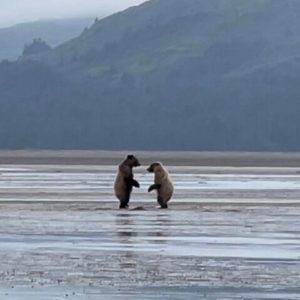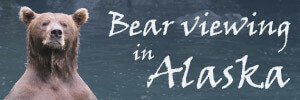Bear Viewing in Alaska
1-907-398-1744, Call Or Text
Camera Gear for Bear Photography: A Buyer’s Guide

Capturing incredible photos of Alaska’s majestic bears takes the right camera equipment. If you’re planning an unforgettable experience, make sure to check out our Ultimate Guide to Bear Viewing in Alaska. Selecting the best camera, lenses, and accessories will help you get eye-catching bear shots to cherish. If you want to ensure you capture every moment perfectly, our Guide to Photographing Bears in Alaska is a must-read. Use this buyer’s guide to find the optimal gear for your Alaska bear viewing adventure.
Choosing a Camera Body
The camera body determines resolution, performance in different conditions, and compatibility with lenses.
- DSLR or mirrorless: These interchangeable lens cameras offer advanced controls and high image quality. Popular models include Canon EOS, Nikon DSLR, Sony Alpha, and Fuji X-Series.
- Crop sensor vs. full frame: Crop sensors are more affordable and compact while full frame models perform better in low light. Either can work well for bear photography.
- Weather sealing: Look for moisture and dust resistance for using cameras outdoors in Alaska’s elements.
- Burst speed: Faster frame rates (10+ fps) freeze fast bear movements.
- Autofocus: Sophisticated AF systems with more focus points track moving bears well.
Best Lenses for Bear Photography
The right lenses capture frame-filling bear portraits or environmental shots showing bears in habitat context. Useful lenses include:
- Telephoto zoom: Versatile lens like a 70-200mm or 100-400mm to isolate bears from a safe distance.
- Prime telephoto: Sharp prime lenses like 300mm or 500mm for crisp detail on bears’ fur.
- Wide angle zoom: A lens like 16-35mm captures bears with surrounding landscapes.
- Fast aperture: Lower f/stops (f/2.8 or lower) create blurred backgrounds and help in lower light.
- Image stabilization: Vibration reduction allows handholding telephotos at slower shutter speeds.
Tripod and Monopod Options
Supporting heavy camera gear is essential for sharp bear shots. Consider:
- Tripods: Sturdy tripods prevent camera shake with telephotos. Look for load capacity of 8+ lbs.
- Monopods: More portable option good for movement and mobility. Use with image stabilized lenses.
- Tripod heads: Ball heads allow smoothly tracking moving bears. Gimbals offer precise control.
- Quick release plates: Enable fast transition from tripod to handheld shooting.
Other Bear Photography Accessories
- Sturdy camera bag or backpack – to safely transport gear by plane, boat, and foot.
- Spare batteries and memory cards – Cold weather drains batteries faster.
- Polarizing filter – Reduces reflections and enhances contrast.
- Neutral density filter – Allows using wide apertures in bright light.
- Camera rain cover – Protects gear in wet Alaskan conditions.
- Sensor cleaning kit – Keep image sensor dust-free.
- Bear spray – For safety when photographing bears up close.
Settings and Techniques for Bear Shots
Along with the right gear, proper camera settings and shooting techniques will help capture stunning bear images:
- Use fast shutter speeds (1/500s or faster) to freeze bear movements.
- Lower ISO settings produce less image noise. Use tripod or monopod to allow this.
- Focus on the eyes for compelling wildlife portraits.
- Shoot low and wide to emphasize bears’ size and habitat.
- Capture expressions like yawns or tooth displays.
- Use burst mode to get the perfect moment in action sequences.
- Try panning to portray motion with creative blur.
Researching the best camera options for capturing Alaska’s bears will help prepare for the photography adventure of a lifetime! Reach out to the bear viewing experts at Bear Viewing in Alaska to start planning your trip today.
Phone Number: 1-907-398-1744
Email Address: gamefish@alaska.net
